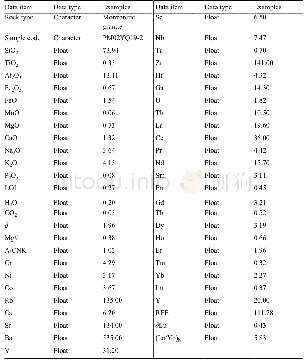《Table 3 Sr-and Nd-isotope data of the Miocene lavas analyzed in this study》
 提示:宽带有限、当前游客访问压缩模式
提示:宽带有限、当前游客访问压缩模式
本系列图表出处文件名:随高清版一同展现
《"Geochemistry and Petrogenesis of Intracontinental Basaltic Volcanism on the Northwest Arabian Plate, Gaziantep Basin, Southeast Anatolia, Turkey"》
The Sr–Nd isotope data of the studied basic lavas are given in Table 3.The primitive Sr–Nd calculations are based on the age of lavas from the study area and similar lavas found in its vicinity,that is,16 Ma(Ilani et al.,2001;Ulu et al.,1991;Arger et al.,2000;Tatar et al.,2004;Lustrino et al.,2010;Ma et al.,2013).The Sr and Nd isotope ratios are usually similar and narrow.This feature indicates that both series of lavas are of homogenized isotopic composition.In the alkaline and calc-alkaline lavas,the initial 87Sr/86Sr isotope ratios change between0.7036562–0.7045744 and 0.7037085–0.7055456,respectively.The Sr isotope ratios are high in the calcalkaline lavas,but their range is very small and close to the ratios of the alkaline samples.Similarly,143Nd/144Nd isotope ratios show similar distributions in the alkaline and calc-alkaline samples.However,one sample of each of the series(A5=0.512640,A3=0.512635)differs from the rest of the samples and shows low Nd and high Sr isotope values.TheεNd values are similar in the alkaline and calc-alkaline samples.Specifically,the values are positive and range between 3.8 and 4.03.TheεNd values in Nd samples A3(0.35)and A5(0.45)are low.These samples differ from the rest because of their lowεNd values.In the Sr–Nd isotopic correlation diagrams,the resemblance between the alkaline and calc-alkaline samples is clearly observed(Fig.7).In these diagrams,the studied volcanic rocks are evaluated with the volcanism existing in their vicinity and on the Arabian Plate(Fig.7).According to the evaluations,the alkaline and calcalkaline rocks(except for A3 and A5)interact with the plateau basalts of the Karacada?volcanic succession to the near east of the region(Fig.7a).The samples found in the depleted source area and MORB region(except for A3and A5)conform to the Neogene-aged lavas of Syria situated on the Arabian Plate and fall in the same area(except for A3 and A5)(Fig.7b) .Samples A3 and A5 are close to the Arabian upper crust data owing to their high Sr isotopic values.The different trends between A3 and A5 and other samples indicate that they may result from different petrogenetic processes similar to the lavas of the Syria–Aleppo Plateau.
| 图表编号 | XD0017170000 严禁用于非法目的 |
|---|---|
| 绘制时间 | 2018.04.01 |
| 作者 | Sevcan KüRüM、Abdurrahman BLüCü、Melek URAL |
| 绘制单位 | Department of Geological Engineering, University of Frat、Institute of Science and Technology, University of Frat、Department of Geological Engineering, University of Frat |
| 更多格式 | 高清、无水印(增值服务) |





